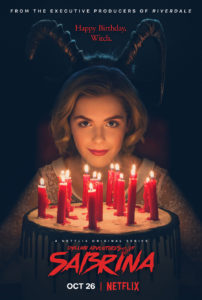TV Review: The Chilling Adventures of Sabrina

The fantasy genre in general and the urban fantasy subgenre especially are chock full of humanistic themes and values that will attract and entertain humanists of all ages. Priorities like caring about human beings more than caring about religious rules and dogmatic traditions abound in the fantasy genre and in the urban fantasy subgenre, which goes a long way towards explaining why the new Netflix show, The Chilling Adventures of Sabrina, is so much fun for humanists.
The show centers on Sabrina Spellman, a young woman who at the beginning of the first episode is about to turn sixteen in the town of Greendale (a town not far from Riverdale, the titular setting of the CW’s popular teen drama). Sabrina’s parents were an interfaith couple who died when she was a child. As a result Sabrina (played by Kiernan Shipka) has been raised by her two aunts, Zelda and Hilda Spellman, and by her cousin Ambrose, who has been under house arrest, in a very literal sense, in the Spellman household since before Sabrina was born. Sabrina possesses a natural magical talent, and her power makes her a target of dark forces that she is initially unaware of. Sabrina is a fearless young woman who is confident in her own magical talent and is unafraid to question the rules that govern the societies she is a part of, a trait that causes her no small amount of trouble, but also changes the world she lives in and oftentimes gives her chances to be a positive and life-changing member of her community.
Moving among non-magical humans, Sabrina lives a by-all-accounts normal life. She attends a public high school, has a boyfriend, and deals with issues any young woman can relate to (an existence referred to as the “Path of Light”). The other world she inhabits is that of witches, ancient and subversive histories, and dark powers—the “Path of Night”. The show’s central premise revolves around the individual lures of both worlds as they attempt to swallow Sabrina up, albeit in very different ways. The plot is reminiscent of conflicts in interfaith families, as members of the extended family attempt to pressure younger individuals to pick one religion or the other.
Sabrina loves to push boundaries and her iconic courage is what enables her to trailblaze and uncover truths hidden from other members of her community, an experience that is relatable to many deconverts and humanists.
Season 1, Part 1 (the full season has actually been split into two parts) of The Chilling Adventures of Sabrina is a tale of humanism, family, growth, and freedom. In a world filled with fantasy, magic, and the supernatural, it’s a clever introduction to skepticism and the complexities of interfaith families and relationships.
It’s worth noting that unlike Sabrina the Teenage Witch, this show is not aimed at children, which could definitely feel like a weakness or at least a limiting factor to some. However, focusing on a more mature audience allows the show more freedom to depict violence, nudity, and themes that parent might find unsuitable for younger audiences. Additionally if someone wants to watch it with theistic family members, be forewarned that the show is deeply subversive to Christian sensibilities. The show is also quite unsettling and can definitely frighten or shock viewers who scare easily.
The singular episode released on December 14 was a Christmas special in which the Spellman family deals with seasonal spirits and a demonic foe who masks himself as a familiar face. During the first season what happens to deceased non-magical humans in the afterlife is discussed and shown, and heart-wrenching events separate Sabrina from one of her family members even in the afterlife. The plot of the episode, which shows a young Sabrina asking Santa to be reunited with her recently deceased parents, is deeply focused on the lengths someone will go to in order to gain some sense of closure in the wake of a loved one’s death and how long people can feel the impact of grief.
It was just announced this week that Netlix will produce a sixteen-episode Season 2 in 2019. Here’s hoping it manages to be as humanistic, thought-provoking, and subversive as the first season!
